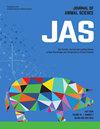440 The effects of reducing dietary nutrient density after the second dose of GnRF immunization (Improvest) on growth performance and carcass characteristics of gilts and intact males
IF 2.7
2区 农林科学
Q1 AGRICULTURE, DAIRY & ANIMAL SCIENCE
引用次数: 0
Abstract
Objectives were to determine the effects of reducing dietary nutrient density after the second dose of GnRF immunization (Improvest; Zoetis Inc.) on growth performance and carcass characteristics. Pigs (n = 1,008) were fed in five diet phases during the 102-d grow-finish period. Diets were formulated to meet 100% of recommended SID Lys to net energy established by PIC (2021) for physically castrated (PC) barrows/non-immunized gilts (regular diet), while diets for GnRF-immunized pigs were formulated with 120% SID lysine than PC barrows/ non-immunized gilts (nutrient-dense diet). During diet phase-4 (2 d after the second GnRF analogue dose), SID lysine and vitamins/trace minerals for the nutrient-dense diet were either maintained at 100% or reduced to 95% or 90%. During diet phase-5 (18 d after second GnRF analogue dose), SID lysine and vitamins/trace minerals nutrient-dense diet were either maintained at 100% or reduced to 90% or 80%. The study consisted of six pen replications (21 pigs/pen) of the following eight treatments: CON-NEG: traditional mixed-sex pigs (PC barrows and non-immunized gilts) that received the regular diet; CON-POS: traditional mixed-sex pigs that received the nutrient-dense diet; I-MALE-100: immunized males (I-MALES) that received the nutrient-dense diet with 100% density; I-MALE-95/90: I-MALES that received the nutrient-dense diet with 95% density during diet phase-4 and 90% density during diet phase-5; I-MALE-90/80 I-MALES that received the nutrient-dense diet with 90% density during diet phase-4 and 80% density during diet phase-5; I-FEM-100: immunized females (I-FEM) that received the nutrient-dense diet with 100% density; I-FEM-95/90: I-FEM that received the nutrient-dense diet with 95% density during diet phase-4 and 90% density during diet phase-5; I-FEM-90/80: I-FEM that received the nutrient-dense diet with 90% density during diet phase-4 and 80% density during diet phase-5. Data were analyzed with PROC MIXED of SAS, with pen serving as the experimental unit. In addition, linear effects of diet dilution for I-MALE and I-FEM pigs were tested using contrast statements. There were not significant linear effects of diet dilution for gain:feed or hot carcass weight in either the I-MALE (P > 0.28) or I-FEM (P > 0.78) pigs. For the overall period, gain:feed was improved by 7.4% for I-MALE pigs compared with the CON-NEG pigs and was improved by 1.6% for the I-FEM pigs compared with the CON-NEG pigs. Hot carcass weight was 3.6 kg greater for the I-MALE pigs compared with the CON-NEG pigs and 1.6 kg greater for the I-FEM pigs compared with the CON-NEG pigs. The results would suggest that removing nutrients during the post-second dose period of GnRF immunization does not negatively affect growth performance or carcass characteristics, while both I-MALE and I-FEM pigs are more efficient and heavier when compared with traditional mixed sex pigs.440 GnRF 第二剂免疫(Improvest)后降低日粮营养密度对后备母猪和完整公猪生长性能和胴体特征的影响
目的是确定在第二剂 GnRF 免疫(Improvest;Zoetis Inc.)后降低日粮营养密度对生长性能和胴体特征的影响。猪(n = 1,008)在 102 天的生长-结束期中分五个日粮阶段饲喂。日粮的配制符合 PIC(2021 年)为物理阉割(PC)公猪/非免疫后备母猪制定的 100% SID 赖氨酸与净能量之比推荐值(普通日粮),而 GnRF 免疫猪的日粮配制为比 PC 公猪/非免疫后备母猪高 120% SID 赖氨酸(营养密集型日粮)。在日粮第 4 阶段(第二次注射 GnRF 类似物后 2 天),营养密集型日粮的 SID 赖氨酸和维生素/微量元素维持在 100%,或降至 95%或 90%。在日粮第 5 阶段(第二次注射 GnRF 类似物后 18 天),SID 赖氨酸和维生素/微量元素营养密度日粮要么保持在 100%,要么降至 90%或 80%。研究包括以下 8 种处理的 6 个重复(21 头猪/栏):CON-NEG:传统的混性别猪(PC 种公猪和非免疫后备母猪),接受普通日粮;CON-POS:传统的混性别猪,接受营养高密度日粮;I-MALE-100:免疫公猪(I-MALES),接受 100%密度的营养高密度日粮;I-MALE-95/90:免疫公猪(I-MALES),接受营养高密度日粮:I-MALE-95/90:免疫雄性猪(I-MALES),在日粮第 4 阶段接受 95% 密度的营养高密度日粮,在日粮第 5 阶段接受 90% 密度的营养高密度日粮;I-MALE-90/80:免疫雄性猪(I-MALES),在日粮第 4 阶段接受 90% 密度的营养高密度日粮,在日粮第 5 阶段接受 80% 密度的营养高密度日粮;I-FEM-100:免疫雌性(I-FEM),接受 100%密度的营养高密度日粮;I-FEM-95/90:I-FEM,在日粮第 4 阶段接受 95%密度的营养高密度日粮,在日粮第 5 阶段接受 90%密度的营养高密度日粮;I-FEM-90/80:I-FEM,在日粮第 4 阶段接受 90%密度的营养高密度日粮,在日粮第 5 阶段接受 80%密度的营养高密度日粮。数据分析采用 SAS 的 PROC MIXED 方法,以栏为实验单位。此外,还使用对比语句测试了日粮稀释对 I-MALE 和 I-FEM 猪的线性影响。日粮稀释对 I-MALE 猪(P> 0.28)和 I-FEM 猪(P> 0.78)的增重:饲料或热胴体重都没有明显的线性影响。与 CON-NEG 猪相比,I-MALE 猪在整个期间的饲料增重提高了 7.4%,I-FEM 猪比 CON-NEG 猪提高了 1.6%。与 CON-NEG 猪相比,I-MALE 猪的热胴体重增加了 3.6 千克,I-FEM 猪比 CON-NEG 猪增加了 1.6 千克。结果表明,在 GnRF 免疫后的第二剂量期间去除营养物质不会对生长性能或胴体特征产生负面影响,而 I-MALE 猪和 I-FEM 猪与传统的混合性别猪相比,效率更高,体重更大。
本文章由计算机程序翻译,如有差异,请以英文原文为准。
求助全文
约1分钟内获得全文
求助全文
来源期刊

Journal of animal science
农林科学-奶制品与动物科学
CiteScore
4.80
自引率
12.10%
发文量
1589
审稿时长
3 months
期刊介绍:
The Journal of Animal Science (JAS) is the premier journal for animal science and serves as the leading source of new knowledge and perspective in this area. JAS publishes more than 500 fully reviewed research articles, invited reviews, technical notes, and letters to the editor each year.
Articles published in JAS encompass a broad range of research topics in animal production and fundamental aspects of genetics, nutrition, physiology, and preparation and utilization of animal products. Articles typically report research with beef cattle, companion animals, goats, horses, pigs, and sheep; however, studies involving other farm animals, aquatic and wildlife species, and laboratory animal species that address fundamental questions related to livestock and companion animal biology will be considered for publication.
 求助内容:
求助内容: 应助结果提醒方式:
应助结果提醒方式:


